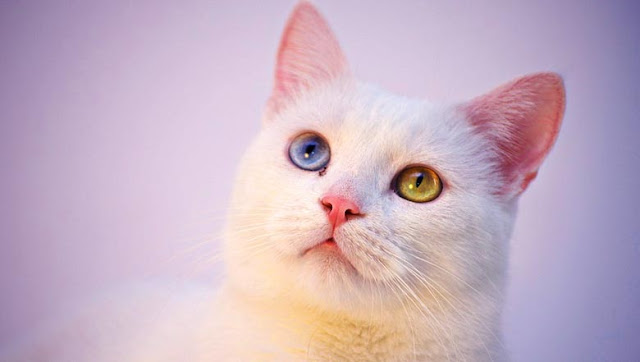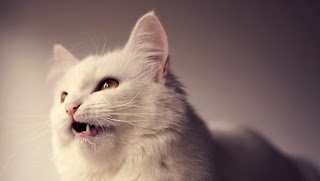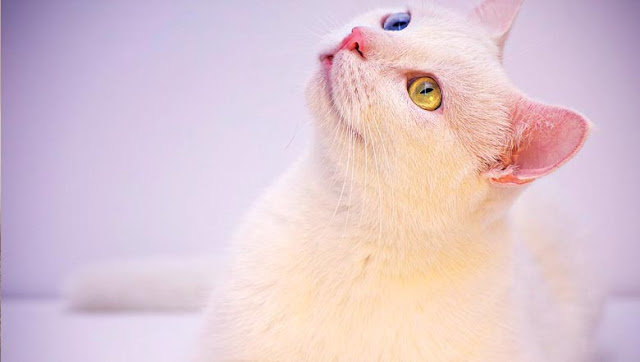The Turkish Angora is referred to as "the oldest cat breed in the world". What about this statement? And why are these long-haire...
The Turkish Angora is referred to as "the oldest cat breed in the world". What about this statement? And why are these long-haired cats so popular?
Genetic research confirms that the Turkish Angora is indeed one of the oldest breeds in the world. Its long coat was born as a result of a natural mutation and not as a result of genetic selection by man, which distinguishes it from many other breeds of cats!
Turkish Angora Aspect
In Turkey, the Turkish Angora, called "Ankara kedisi" was raised to the rank of national emblem. It is not surprising that this muscular and elegant cat, weighing up to 5 kilos, seduces many cat lovers. The coat of the Turkish Angora is distinguished by its silky texture. The Turkish Angora has no undercoat, which makes it particularly easy to care for. This cat has a thick coat with a marked collar in winter and a particularly short, light and silky coat in summer. The climate of its region of origin explains this peculiarity: the Turkish Angora adapts perfectly to the hot summer and cold winter of the mountainous regions of Anatolia and the Caucasus.
Its tail is long and very full. With its elegant silhouette and long legs, the Turkish Angora may seem delicate, but do not be fooled! The head of the Turkish Angora is wedge-shaped from the base of the ears to the tip of the muzzle. Its shaped eyes are particularly piercing. A lot of attention is also paid to the ears of purebred cats: many breeders prefer cats with large open ears with fine feathers.
The physical appearance of the Turkish Angora has evolved over time. No wonder, since this cat breed, known since the 15th century, has a long history behind it! These cats of Turkish origin, imported to Europe were already powerful and robust. Since then, breeders and breeding organizations have chosen to privilege the modern and rather slender type of this breed cat.
Until the 1990s, only white cats were recognized by the Turkish Angora breed standard. Moreover, still today in Turkey, the rule is that the Turkish Angora has a white coat. Then, color varieties were also introduced in (International Feline Federation). Since then, the Turkish Angora is recognized by all associations, even with black and red dresses, as well as in the diluted and silver variants of these colors. Other variegations as well as tabby patterns can be encountered. On the other hand, color variations such as chocolate, fawn, lilac and dot are neither desired nor recognized.
Unlike other pedigree cats such as the Ragdoll, the Turkish Angora can show all iris colors. Whether it is green, gold, gold green, copper, blue or mink, there is no relation between the color of the eyes and the coat.
Character of the Turkish Angora
Even if the Turkish Angora loves outdoor adventures and walking at will, escapades in the wild often involve danger. Purebred cats left unattended often place too much trust in strangers and often approach them with friendly purring. Many animals do not hesitate to get into the car of strangers! A cat that likes to roam should therefore always be microchipped and registered with the pet registry, so that it can be identified if necessary and quickly find its way home!
Check out the cat accessories category at your local zooplus store. There you'll find some real treasures for your Turkish Angora!
The Turkish Angora History
Is the Turkish Angora really the oldest pedigree cat in the world? Scientists have looked into this question and have shown, with the help of genetic research, that the gene of the Turkish Angora's longhair is indeed caused by a natural mutation. Contrary to other breeds, the Turkish Angora breed is not derived from a lineage by targeted selection and can be considered one of the oldest cat breeds in the world!
The Turkish Angora originates from the Caucasus and is closely related to the Van. It has been known in Turkey since the 15th century. In the sixteenth century, sultans of the Ottoman Empire sent it to the royal courts of England and France as a gift and also made it known in Europe. Its long and majestic dress attracted the attention of rich aristocratic elites. But the Turkish Angora was not only appreciated at court. Scientists and natural history researchers were fascinated by the noble cats with their silky coat. In 1756, the Turkish Angora was already mentioned in a book by the French naturalist Georges-Louis Leclerc de Buffon and depicted on illustrated plates.
In the 18th century, cats were symbols of social status in European courts. In 1834, William Jardine, a Scottish physicist and businessman wrote: "Angora cats are often found as small parlor cats. They have a gentler and more affectionate character than other cats". In 1868, Charles Ross gave another description of the Turkish Angora: "The Turkish Angora is a magnificent breed with silvery hair and silky texture (...) They are all fabulous creatures with an affectionate character".
The breeding of Persians, however, overshadowed the Turkish Angora, which saw its population decline critically even in Turkey. In zoos in Ankara and Istanbul, some Turkish Angora cats were even kept in captivity to prevent the extinction of the breed.
The 1950s marked the birth of modern Turkish Angora breeding. In 1954, the first Turkish Angora arrived in the United States, where it was recognized from 1973 by the American Cat Breeding Organization CFA, at first only with a white coat. Colored cats were only recognized in 1978. The breeding finally developed essentially from cats imported from Turkey. It is interesting to note that these were mainly cats imported from zoos.
Turkish Angora Health and Wellness
The Turkish Angora has a predisposition to ataxia, which is a movement coordination disorder. These cats with a wobbly appearance present a neurological disorder, leading to coordination problems. With a lot of care and specific treatment by the veterinarian, cats with ataxia can still have a good life expectancy! The origin of the appearance of this disease is not yet known, but it is certain that it is present at birth, since adult cats cannot contract it.
It also turns out that all-white cats often develop hearing and deafness problems. There are also disturbances in the sense of balance. These problems are not specific to the Turkish Angora breed, but this condition is common in many all-white Angora cats.
Turkish Angora Care and Nutrition
Robust and healthy, the Turkish Angora does not need any special care or diet. The best way to ensure a long and healthy life is to offer a good quality cat food, rich in healthy proteins. Like any carnivore, the cat is fond of good quality proteins. On the other hand, cats should not eat too many carbohydrates, as they are exposed to side effects such as diabetes.
"Tell me what you eat and I'll tell you who you are". This proverb also applies to our house cats. It is scientifically proven that cats know exactly what is good for them. They prefer food with a composition that corresponds to that of the mouse, which is the basic diet of the carnivore. This prey consists of approximately 85% protein (which includes muscle, muscle mass and organs). The rest consists of certain plant components in the digestive tract. A mouse therefore generally consists of 50-60% protein, 20-30% fat and 3-8% carbohydrates, which are contained in the animal's digestive tract. An optimal cat food should therefore come as close as possible to this composition.
Contrary to all expectations, it is very easy to find out which ingredients a cat food really consists of. All cat food labels list the ingredients according to their quantity in the finished product: the ingredient that is present in the greatest proportion is therefore in first place. It is therefore not surprising that meat is at the top of the ingredient list. Beware, not all meats are the same! The words "meat and animal by-products" indicate that, in addition to meat and muscle, a number of by-products and waste products such as organs and tendons are present in the product.
On many food labels, the famous "guaranteed analysis" can be found next to the list of ingredients. This is a quantitative chemical analysis of the substances contained in the food. In most cases, you will find the percentage values for crude protein, crude fat, crude fiber and moisture, and sometimes even information about the vitamin and mineral content. You can therefore estimate at a glance whether the food you buy commercially is really healthy for your cat!
In addition to a good diet, Turkish Angoras should also be examined every year by a veterinarian, so that the veterinarian can perform the necessary vaccinations and examine your cat's dentition. A quick check-up of the heart and lungs is also part of the annual "check-up" in order to detect possible illnesses in time.
Finding the right breeder
Of course, the Turkish Angora does not belong to the most famous cat breeds, but if you want to buy a Turkish Angora, no need to go all the way to Turkey. There are many breeders established in France, Germany and Switzerland.
A pedigree cat will reflect the home in which it will have grown up. Professional breeders attach importance to the membership of a breeding association and take care to provide the required prevention in terms of health as well as quality food to their animals. This naturally comes at a price. It is possible to find pet cats from $500, but breeding animals are often more expensive. Make sure that the breeder not only provides you with the papers of your future cat, but also that he shows you his commitment and experience as a breeder. Costs for food, vet visits, mother and kittens are rarely fully covered by the purchase price of the cat. Breeding is an expensive activity. Do not trust "mass breeders" who offer "undocumented purebred cats"! These people do not breed responsibly or thoughtfully, rarely give cats the necessary preventive care, do not perform genetic testing, and do not promote good nutrition.
A responsible breeder is able to show you the veterinary examination documents as well as the parents' papers, and gives his kittens 12 weeks to grow and learn from their mother and siblings. Only then are the kittens ready to integrate into their new family. During the next 12 to 18 years, your Turkish Angora will be an integral part of your life and will enchant you with its character!
We wish you a lot of fun with your Turkish Angora!





No comments